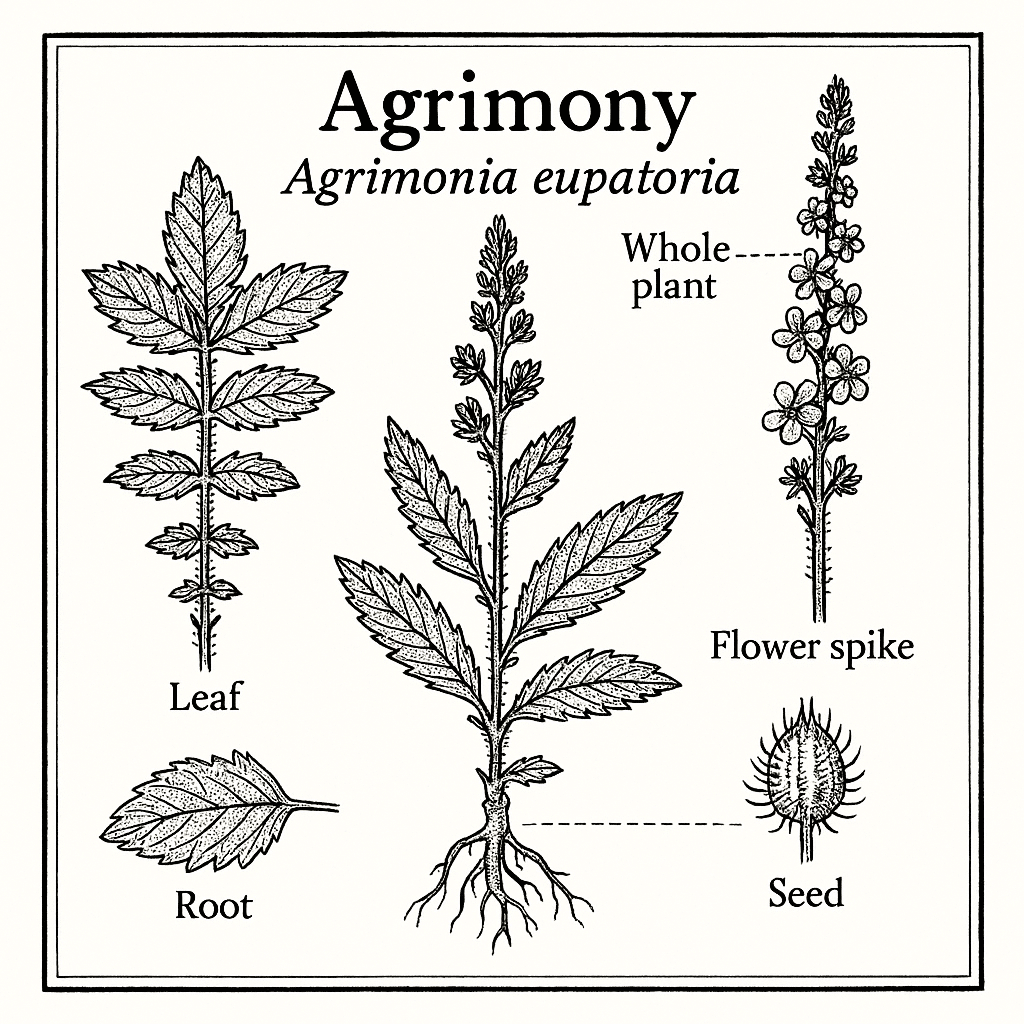Agrimony
Agrimonia eupatoria — Materia Medica

Snapshot
Tannin-rich aerial parts (leaf & flowering tops) traditionally used as a gentle astringent and mucosal tonic. Taken as a tea or tincture for mild, self-limited digestive upset and used as a gargle/wash for throat and minor skin irritations. Key constituents include hydrolysable tannins (e.g., agrimoniin) and flavonoids.Agrimonia Eupatoria: Comprehensive Guide to Its Therapeutic Effects and Uses
Introduction to Agrimonia Eupatoria
Agrimonia eupatoria, commonly known as agrimony or fragrant agrimony, is a perennial herbaceous plant belonging to the rose family. Widely recognized in traditional medicine, agrimonia eupatoria has been used for centuries for its diverse therapeutic effects, particularly in digestive system support, liver and gallbladder diseases, wound care, and urinary tract health.
Botanical Characteristics and Habitat
Common agrimony grows in temperate regions of the Northern Hemisphere, thriving in grasslands, woodland margins, and hedgerows. It features compound pinnate leaves with serrated edges, yellow star-shaped flowers, and a distinct fragrant aroma. As a member of the rose family, agrimonia eupatoria contains numerous bioactive compounds including phenolic acids, flavonoids, and tannins.
Traditional Medicine and Herbal Uses
Agrimonia eupatoria has a long history in traditional medicine as a remedy for upset stomach, diarrhea, liver health, and inflammatory conditions. It is valued for its astringent properties, attributed to chemicals called tannins, which promote mucosal membrane toning and digestive function. Herbal medicine practitioners often use agrimony in herb combinations consisting of multiple medicinal plants to enhance therapeutic effects.
Chemical Composition and Qualitative and Quantitative Standardization
The therapeutic effects of agrimony are linked to its rich content of phenolic acids, flavonoids, triterpenoids, and volatile oils. These compounds contribute to its antioxidant effects, radical scavenging capacity, and anti inflammatory properties. Modern herbal research focuses on the qualitative and quantitative standardization of agrimonia eupatoria extracts to ensure consistency and efficacy in health care applications.
Therapeutic Effects on the Digestive System
Agrimony supports digestive function by promoting cellular glucose metabolism and improving glucose absorption. Studies on streptozotocin diabetic mice have demonstrated agrimony’s traditional anti diabetic actions, including enhanced insulin secretion and a significant reduction in blood sugar levels. Its bitter and astringent qualities stimulate gastric secretions and help regulate bowel movements.
Agrimonia Eupatoria and Liver Health
Agrimony’s extract alters liver health positively by protecting against liver damage and liver injury. Clinical trials, including double blind trials, have shown a significant reduction in elevated alanine transaminase levels in subjects consuming agrimony aqueous extracts prepared from aerial parts. These effects support its use in treating liver and gallbladder diseases and improving overall liver function.
Antioxidant and Immunomodulatory Properties
The herb’s antioxidant enzymes superoxide dismutase, catalase, and glutathione are stimulated by agrimony, enhancing the body’s defense against oxidative stress. Agrimony also modulates anti inflammatory cytokines, contributing to its therapeutic effects in inflammatory conditions such as chronic eczema and psoriasis.
Antiviral and Antimicrobial Activities
Agrimonia eupatoria exhibits antiviral properties against negative sense RNA viruses and inhibits hepatitis B virus by reducing hepatitis surface antigen levels. Its antimicrobial action is effective in wound healing activity, particularly in infected wounds caused by Staphylococcus aureus. Topical therapy with agrimony extracts promotes cell migration and induces fibronectin release, accelerating tissue repair and further sunlight damage prevention.
Use in Wound Care and Skin Conditions
Agrimony’s ability to tighten tissues and create protective barriers makes it ideal for topical therapy in wound care. It is used to treat chronic eczema, purulent wounds, and cutaneous porphyria obtained through herbal applications. The herb’s wound healing activity is enhanced by its photosensitizing properties, which stimulate cellular proliferation and promote cell migration.
Effects on the Urinary Tract and Fluid Retention
Agrimonia eupatoria acts as a diuretic and mucosal tonic in the urinary tract, helping alleviate cystitis, bladder atony, and urinary incontinence. Its anti inflammatory properties support tissue healing and reduce fluid retention, making it beneficial during menstruation and related conditions.
Safety, Dosage, and Precautions
While agrimony is generally considered safe in appropriate doses, caution is advised for pregnant and breastfeeding women. The appropriate dose varies depending on age and health status, with modern medicine recommending consultation with health care professionals before use. Agrimony may interact with diabetes medications, requiring blood sugar to be monitored closely.
Conclusion: Agrimonia Eupatoria in Modern Herbal Medicine
Agrimonia eupatoria remains a valuable medicinal herb traditionally and in modern herbal medicine. Its broad spectrum of therapeutic effects, including antioxidant effects, anti diabetic actions, antiviral and antimicrobial activities, and liver health support, make it a promising herbal remedy. Further research and clinical trials will continue to elucidate its full potential in health care.
Identification & Harvest
Harvest upper, leafy flowering tops early in bloom; avoid coarse stems. Dry promptly with airflow to preserve tannins; store airtight away from humidity and light.Preparations
- tea-infusion
- tincture
- compress
Safety
Generally well tolerated in typical tea/tincture amounts for short periods. High tannin content may reduce absorption of medicines and non-heme iron—separate by several hours. Avoid with chronic constipation or significant GI irritation. Discontinue if hypersensitivity occurs.Related Research
No studies yet.
References
- (2015) European Union herbal monograph on Agrimonia eupatoria L., herba (HMPC)
- (2015) Assessment report on Agrimonia eupatoria L., herba (EMA/HMPC)
- (2024) Plants of the World Online — Agrimonia eupatoria L. (Kew)
- (1982) Agrimoniin: a doubly linked dimeric ellagitannin from Agrimonia eupatoria
- (2021) Cleavage of the ellagitannin agrimoniin and antiproliferative activity
- (2004) Herbal Drugs and Phytopharmaceuticals (Wichtl, ed.) — Agrimonia monograph
- (2013) Principles and Practice of Phytotherapy, 2nd ed. (Bone & Mills) — Astringent herbs overview
- (2003) Medical Herbalism (Hoffmann) — Tannins & astringents
Educational content only; not medical advice.
